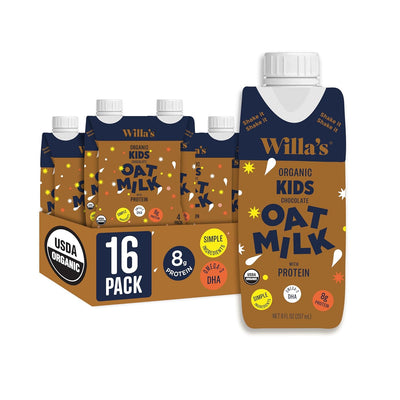Coffee and Plant Milk Pairings

Coffee and milk: what could be a more classic combination of flavors? The sweetness and creaminess of milk perfectly balances the bitterness and acidity of coffee.
Whether for dietary or ethical reasons, choosing a non-dairy partner/pairing/alternative for our daily coffee calls for careful consideration. Whereas cow’s milk tends to taste more neutral, plant-based milks have recognizable flavor profiles of their own. Choosing the right milk to blend with the right coffee can allow the flavor of both your coffee and your milk to shine! Here’s a quick guide on how to choose the best plant milk to pair with your coffee.
Soy Milk
Soy milk is the OG specialty coffee milk alternative. While public opinion of soy milk has been controversial in recent years - leading some coffee shops to drop it from their menu entirely - it’s still a popular and widely available plant milk. It’s also got some baggage on the sustainability side of things.
Soy milk’s flavor can vary widely from brand to brand, but in general, it is moderately sweet with a rounded, creamy mouthfeel. It has a distinct nuttiness and grassiness that pairs best with coffees that are sugar-sweet with balanced acidity and which have enough body to cut through the milk. Washed-processed coffees from Central and South America with a well-developed roast profile like Parlor’s Colombia Los Angeles make the perfect pairing.
Pro-tip: Avoid soy milk with a high content of thickeners and stabilizers. While these will definitely make for a creamier cappuccino, the added thickeners can make soy milk taste gritty or chalky when steamed.
Almond Milk
The brighter, fruit-forward notes of light roasts fare a little better in almond milk than soy milk. That being said, the watery, and, in some cases, chalky, texture of the almond milk can make for a less satisfying drinking experience. Almond milk has the sweetest profile out of most plant milks, which makes it trickier to pair with coffee. This sweetness balances coffees that are inherently ripe and juicy, like coffees grown in East Africa, particularly from Kenya, Rwanda, and Burundi. In general, almond milk is best paired with delicate coffees. And in our opinion, naturally-processed coffees, or “dry-processed” coffees make the most ideal pairing. Just be wary of the sugar content of some brands of almond milk since too much sweetness will overpower any coffee. In our opinion, the best coffees to pair with almond milk would be naturally-processed (also called “dry-processed”) coffees
For an almond milk espresso flavor bomb, try a perfectly steamed 6oz cappuccino made with a naturally-processed Ethiopian coffee. Our go to is Madcap’s Party Roast, a blend composed of both natural and washed Ethiopian coffees.

Oat Milk
Of all the popular plant milks, oat milk bears the closest resemblance to cow’s milk in taste, texture, and the way that it steams and pours into espresso. In fact, latte art poured with oat milk can be just as effortlessly crisp and detailed as when poured with cow’s milk. This is usually not the case with other plant milks. Barista oat milks need a bit of oil to steam and foam properly. Just make sure that the oat milk you’re using doesn’t have an excessive amount of a poor quality, highly processed oil, otherwise the latte art will be blotchy and hard to pour. Willa's Barista Oat Milk is recommended for latte art because it foams using only organic high-oleic sunflower oil, creating lovely layers of foam without the bad fats.
If you had to pick just one plant milk, oat milk would be the way to go for its versatility alone. Unlike other plant milks, oat milk’s more neutral flavor profile acts as a blank canvas—making it the goldilocks of plant milks. It pairs elegantly with coffees on the lighter side of the roasting spectrum, allowing for the inherent character of the coffee to take center stage. When combined with a more traditional, full-bodied and rich espresso (think coffees from Brazil and Indonesia), the resulting latte or cappuccino will be luscious, creamy, chocolate-y and toffee-sweet. For a truly memorable coffee drinking experience, we think lightly-roasted, honey-processed coffees from Central and South America (especially from Costa Rica and Colombia) make a stellar oat milk pairing. Honey-processing itself is a kind of “just right” processing method. You get the clarity and sharpness from a washed-process coffee, plus the depth of flavor, sweetness and floral qualities that make natural coffees so unique and delicious. These coffees are a little more expensive than others, but we believe they’re worth it.
The Other Milks
While they haven’t quite caught on to the mainstream yet, some coffee shops are experimenting with additional plant milks like hemp milk, cashew milk, rice milk, and coconut milk. These alternative milks tend to be either too thin to steam well or their flavor profiles overpower the coffee, making them less than ideal pairings.
How to Pair
In order to pair the right milk with the right coffee, you just need to get a little familiar with the flavor profiles of the various coffee origins. Here are a couple rules of thumb: Coffees from East Africa tend to be tart, juicy and floral, pairing best with plants milks with lots of natural sweetness; Coffees from Central and South America, Indonesia, and Hawaii pair well with plant milks that are creamy and have a nutty flavor profile; Naturally-processed coffees need a neutral plant-based milk to act as a backdrop in order for their complex bouquet of aromatics and ripe fruit qualities to come forward.
And of course, the right oat milk will always hit the right notes.








